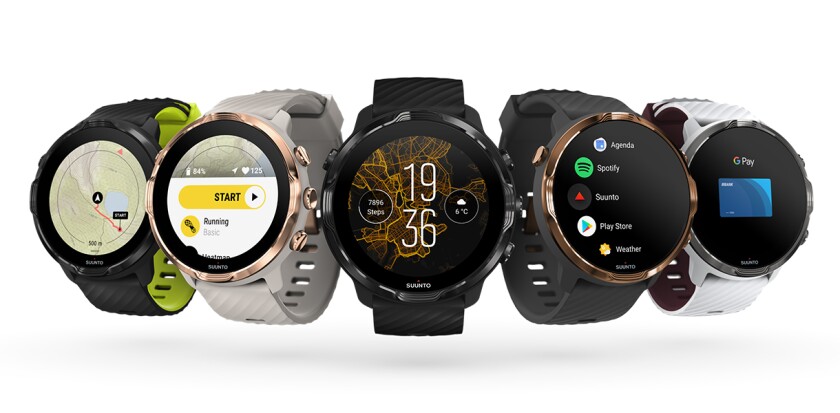No longer a novelty item, smartwatches have emerged from the shadow of mobile phones as way-cool gadgets in their own right.
On the one hand, they’re fashionable. You can switch watch faces with a single swipe, depending on your mood. That’s a pretty versatile accessory.
More important, smartwatches have established themselves as an increasingly important healthcare technology, allowing users to monitor everything from fitness and sleep to the ticking of their hearts.
With all that in mind, here are some of the best wearables available as the holiday shopping season begins in earnest.
The Apple Watch, needless to say, remains the gold standard.
The latest iteration of the industry-leading technology, the Apple Watch Series 6, incorporates everything people liked about the Series 5 — the sleek look, the top-notch software — and takes it up a level.
But does that justify prices that start at $400 and surpass $1,000 for top-of-the-line models? I’m not so sure, especially if you’ve already got a Series 5.
The big advance of the Series 6 is a blood oxygen sensor. If you have a heart or lung condition, this can be a good thing to closely monitor.
For everyone else, it might not be a data point you want to obsess over (and you certainly shouldn’t make any changes without consulting a doctor).
This is a good example of how wearables represent different levels of utility for different medical conditions. For instance, I have Type 1 diabetes, and real-time data from a blood-sugar sensor on my abdomen feeds into my watch.
This is by far the most valuable tool I have for managing my illness, making my smartwatch indispensable from a healthcare perspective.
I suspect the killer app for many people without underlying conditions will be real-time monitoring of blood pressure. This capability is already available overseas on some watches and now awaits approval from the Food and Drug Administration for use by Americans.
Blood pressure data can prove very handy in managing stress and spotting a variety of possible medical issues. I’d be very curious about how my numbers vary throughout the day.
In the meantime, you may want to consider the new Apple Watch SE, which starts at less than $300 and does pretty much everything the Series 6 does except blood-oxygen and heart-rate checks.
Samsung’s Galaxy Watch 3 is a strong competitor to the Apple Watch.
(Samsung)
The main alternatives to the Apple Watch are the Samsung Galaxy Watch and wearables featuring Google’s Wear OS software.
The Galaxy Watch 3, like the Apple Watch, offers an impressive package of hardware and software, although you may need to use a Samsung Galaxy smartphone to enjoy its full functionality. Also like the Apple Watch, it monitors both heart rate and blood oxygen.
For me, the Galaxy Watch takes top marks for style. Its round face (available in 41- and 45-milimeter versions) looks “watchier” than Apple’s device, which is something I prefer, although your tastes may differ. (Rumors persist that Apple may introduce a round watch.)
Some apps are incompatible with Samsung’s proprietary Tizen operating system, so make sure in advance it can handle what you want. Prices start at $400.
When it comes to Wear OS watches, the market leader is Fossil, which keeps churning out classic and cutting-edge styles under its own and other brands.

Fossil’s Generation 5 Garrett watch combines rugged good looks with Wear OS functionality.
(Fossil)
Fossil’s latest Generation 5 models, with faster chips, are as good as anything available, and typically are offered at a lower price point (think closer to $300 instead of $400, on average).
I sampled the Gen 5 Garrett model, which has the rugged good looks of a dive watch (but remember it’s an electronic device, not something you want to get wet for prolonged periods). It’s a handsome device, with plenty of power under the hood to manage everything I threw at it.
Another Wear OS watch worth checking out, especially if you’re the outdoorsy type, is the Suunto 7 from Finland. This powerhouse is designed to compete with Garmin GPS models for back-country adventures.
The first impression of the Suunto 7 is that it’s big, with a 50mm case. Yet it’s also lighter than expected (70 grams) and comes with arguably the most comfortable rubber watch band on the market.

The hefty Suunto 7 from Finland targets outdoorsy types seeking GPS options.
(Suunto)
The hefty watch face quickly proves its usefulness when you access the mapping functions. It kept accurate tabs on my location even as I hiked with my dog in the mountains.
The larger size also accommodates a more robust battery than many smartwatches.
Most wearables, particularly those with always-on displays, need to be recharged nightly. The Suunto 7 can last two days between charges.
This one’s a little pricey at about $450, but there should be markdowns as we approach year’s end. Just make sure you have sufficient real estate on your wrist to handle something this massive.

Diesel’s Fadelite turns heads with its stylish good looks.
(Diesel)
The biggest surprise for me in checking some of the top wearable tech was the Diesel On Fadelite, another Wear OS offering from the Fossil family.
Diesel is best-known for its bulky, industrial-style watches. The Fadelite is slim and trim, and the plastic case comes in different transparent colors — black, red, blue and clear. The clear is coolest.
My first impression when I took it out of the box was that it looks like a toy, a starter watch for a kid. Aside from the see-through case, there’s a shiny metallic ring around the face that seems to change color depending on the light.
But of all the wearables I wore around the neighborhood while researching this piece, the Fadelite received the most compliments for its simple lines and peppy styling.
At $275, this one’s also the cheapest of the bunch. A sweet deal indeed.





